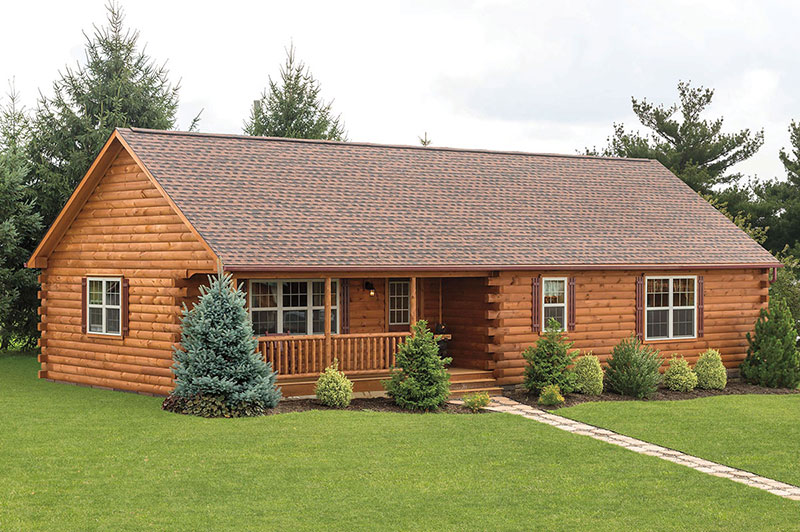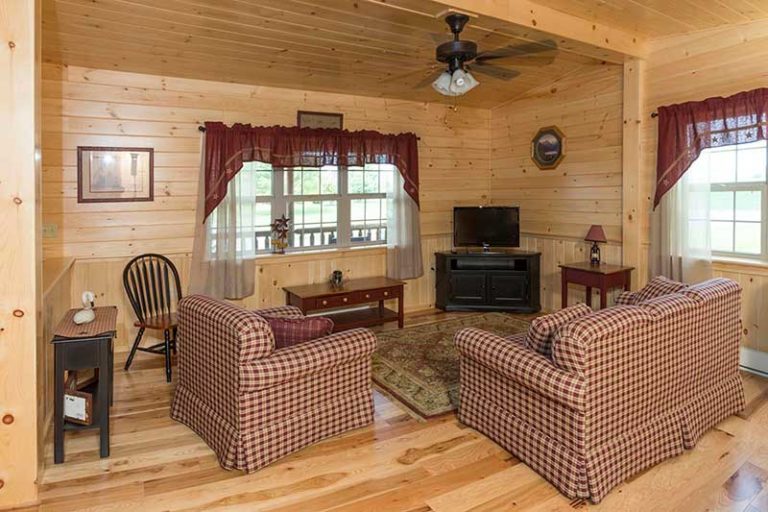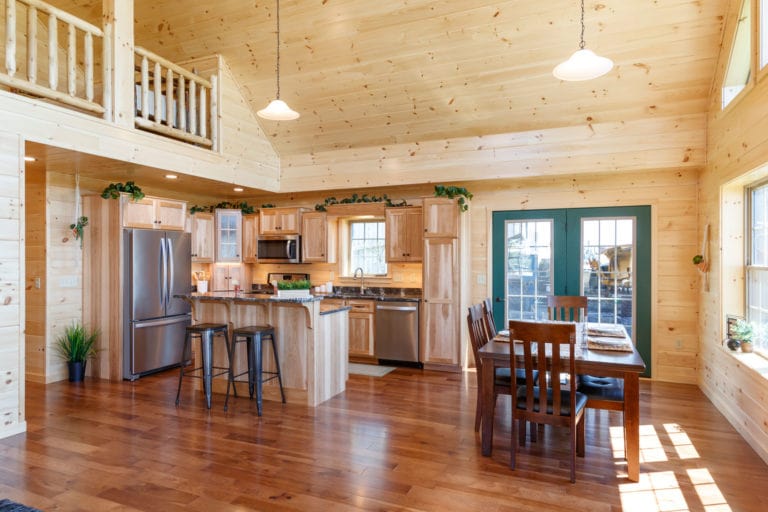
It’s a breezy autumn night and you’re finally settled in at home. It’s a cozy feeling and you can’t believe you get to call this place your home. Sounds like a dream, right? There are a lot of appealing features of log cabins that make them either a perfect forever home or your ideal vacation getaway.
After reading this blog, you’ll know some of log cabin homes’ pros and cons, and different log cabin home design features that are completely customizable to exceed your expectations and needs.
Skip ahead to learn more about log cabin homes:
Advantages of Log Homes
You’ll find that there are many benefits of log cabin homes. These benefits will help your wallet, the environment, and your over-well being. Below, we’ll go in-depth on some advantages so you can start to picture yourself in a log cabin.
#1 Your Log Cabin is Long-Lasting and Environmentally Friendly
The construction process of a log cabin makes it a better choice for you and the environment. Since trees are a renewable resource, the building process is more sustainable compared to other conventional construction methods.
The durability and stability of log cabins also mean they can last you much longer than your lifetime. Additionally, a benefit to log cabin homes is that they withstand intense weather conditions, including hurricanes and strong winds.
With other homes, you need a variety of materials to complete the construction process. With a log cabin, your main building material is wood, so not only is this a more environmentally friendly option but it will also save you time and money.
Interlocking logs mean your cabin is waterproof and your roof will be sturdy enough to withstand heavy snow and ice. Additionally, when you purchase a log cabin from Penn Dutch Structures, you’ll receive a five-year warranty on a structure that is built to meet regulations and standards.
#2 Your Log Cabin Will Be Quiet and Peaceful
If your current home resides in a bustling neighborhood or city, it can be frustrating and distracting to hear cars driving by, neighbors in their homes, or other outside noises. Investing in a peaceful and quiet second home can help you destress and get away from your busy life.
A benefit of log cabin homes is the wood materials create a sense of comfort and warmth as well as dampen the sound outside. With significant noise reduction, you will find fewer distractions from the outside world.
#3 Your Log Cabin Can Be An Ideal Getaway Home
Maybe you’re not looking to permanently move into a log cabin, but the benefits of owning a second home are significant.
Let’s begin with how a second home can benefit you and your family. For starters, you’ll always have a place to get away and you won’t have to worry about paying to stay there. An additional home is ideal for weekend getaways or shorter, last-minute stays when you need a quick trip.
If your family and friends frequently go somewhere to fish and hunt, investing in a log cabin can make these trips easier and more enjoyable. Pairing a new log cabin with a hunting blind optimizes your hunting experience.
Not only will you be able to use the log cabin whenever you want, but if you’re not using it you can rent it out to others. Listing your cabin as a vacation rental can bring in additional income for you. We’ll go into more detail about vacation rentals in our next step.
#4 Your Log Cabin is a Great Return on Investment
As stated earlier, your log cabin is long-lasting and durable so you can use it for more than a lifetime’s worth of memories.
Additionally, a vacation rental can be a great investment for you to have a second income. If you’re deciding to go that route, it’s important to have an intense cleaning system, and a solidified team to help you maintain the property
As a rental property, you will need to be prepared to answer questions and requests of your guests. The decision to rent out your log cabin should be given serious consideration so you can feel well prepared for maintaining and improving the guest experience.

Disadvantages of Log Homes
Like anything else, you’re going to come across some disadvantages and cons. Log cabins are no different. Below, we’ll outline some problems with log cabin homes.
#1. Without Care, Your Log Cabin Can Deteriorate
As with any home, without care and maintenance, you’ll deteriorate the value of your log cabin. Specifically, log cabin exteriors need to be washed and inspected for pests and critters. It’s likely that your cabin will need to be resealed and caulked every 3 to 4 years in order to maintain high quality.
You should also check for mold and mildew and then remove them if necessary. With the main building material being wood, log cabins may experience moisture issues if not treated properly. One way to combat this is to plant gardens away from the siding of your home and build topsoil around the foundation of your home in order to help drain excess water.
Intense sunlight can cause discoloration and cracking on your log cabin. This is why it is essential to repaint the exterior finish of your log cabin. This will not only help brighten and revive the color but will also be proactive against mildew, mold, and rot.
We’ve created a log cabin maintenance checklist if you want to see what we recommend doing to make sure you get the most out of your investment.
#2 Your Insurance Costs May Increase
Depending on whether your log cabin is your permanent home or a vacation home, you will need to make sure that you can cover the structure under your insurance. Secondary homes are typically more costly on your insurance policy.
A disadvantage to log homes is that they can be even more costly because of the building materials used. Other effects include how often your log cabin is unoccupied during the year. An empty home is more likely to be broken into, so your insurance policy will increase.
Finally, the location of your log cabin will affect your homeowner’s insurance. If you are located in either a remote location or somewhere that is more susceptible to harsh weather storms, you’re likely to see an increase in insurance costs.
Choosing Your Log Cabin Home Design
Log cabin home pros and cons should be taken into careful consideration before deciding to invest in a log home. However, if you decide that you want to take the next step, it’s time to build your log cabin floor plan.
Questions to ask as you create your log cabin home design.
- How much time will you spend at the home? Will this be your forever home or a vacation getaway?
- What’s the maximum number of people that will stay at your cabin the majority of the time?
- What are your must-haves for design features and floor plans?

Interior Features to Consider
A notable benefit to a Penn Dutch Structure log cabin is that many features are customizable and catered to your specific needs. Below are some interior features to consider in your log cabin home design.
- Interior Finish. You may either decide that the entire interior will be wood, or you can mix in different finishes such as marble, hardwood, tile, or vinyl.
- Kitchen. When designing your kitchen, think about whether or not you’ll need lots of storage space and how much surface space you’ll need to cook. This will help you decide how many cabinets to incorporate and if you’re interested in putting an island in.
- Countertops. A Penn Dutch Structures log cabin can be customized with marble, quartz, or solid or laminated countertops.
- Windows. Depending on the location of your log cabin, you may want large windows overlooking a lake or big forest. Our Mountaineer Deluxe cabin highlights the vista glass view.
- Number of Rooms. Your log cabin floor plan will highlight the number of rooms you have. This should be decided based on how many people will consistently be residing in your cabin, or if you believe you’ll frequently have guests stay the night.
Exterior Features to Consider
Similar to the interior of your log home, you’ll have customizable options for your exterior. Below, we’ll go through some of the main decisions you’ll have to make to complete your log cabin home design.
- Shingles and Doors. At Penn Dutch Structures, you can choose from multiple colors of shingles and doors to compliment your log home.
- Roof. We offer a steel roof in a variety of colors such as black, brown, burgundy, and green. You may also decide to add a permanent roof decoration to further enhance your home and boost curb appeal.
- Porch. One unique benefit of log cabin homes is they may overlook a beautiful lake or scenic forest. If that’s the case, including some sort of porch or deck would be beneficial. A porch swing would also be a great addition to drinking your morning coffee or catching up with friends.

Whatever features you decide to include in your log cabin floor plan, it should be a place that helps you relax and keeps you cozy. At Penn Dutch Structures, we’re here to bring your vision to life.
After choosing a design for your log cabin, we suggest reading our blog post addressing frequently asked questions about log cabins.
Your Warm and Homey Log Cabin Design is Waiting For You

